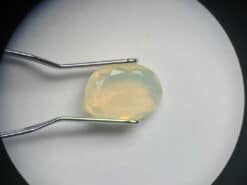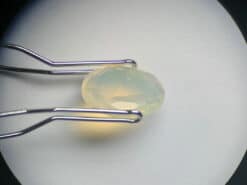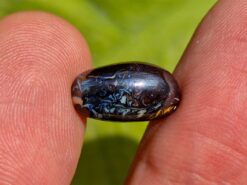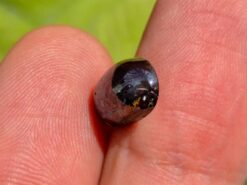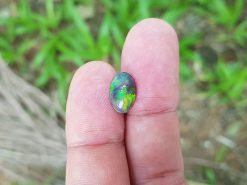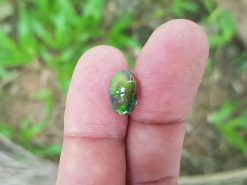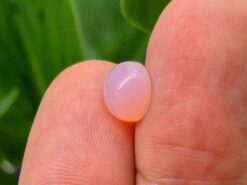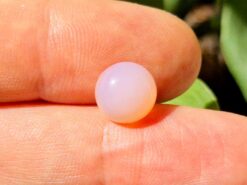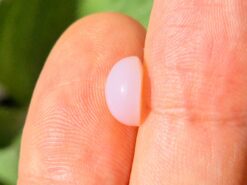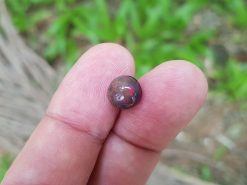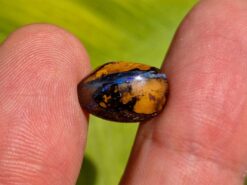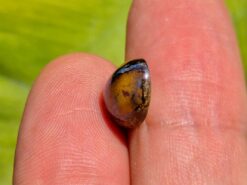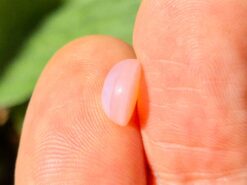Welo opal
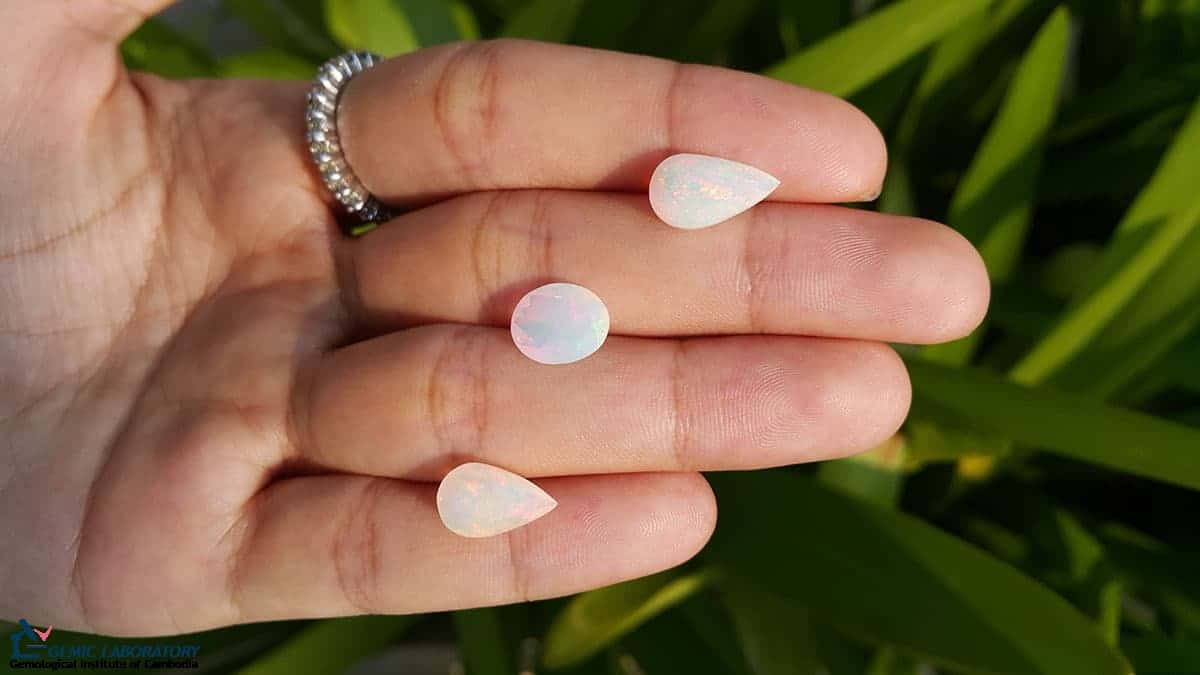
Buy natural opal in our shop
Ethiopian opal
We know, of course, the famous Australian opals. But for a few years now, a new gem has appeared on the market that captivates collectors and jewelry lovers: Welo opal. This stone can be found in various forms such as Welo opal rough, black, white, and fire color. Typically, it is white and translucent, displaying a unique and mesmerizing play of color. Its deposits are mainly located in the Semien Wollo mountain in northwestern Ethiopia. The exact date of discovery remains uncertain, although black Welo opal is known to be treated and usually commands a cheaper price than the natural white or fire color variations.
Some sources mention that Welo opal was first spotted around 1993 in Nairobi markets, with geological engineer Telahun Yohannes credited for the discovery. In 1994, Dr. N. Barot also mentioned its existence in a published article. About 10 kilos were extracted as early as 1997, but it wasn’t until 2008 that its true exploitation started. Around 400 grams were cut by the Eyaopal workshops in Addis Ababa, and that same year, this new gem was showcased at international mineral exhibitions, including Sainte-Marie in France. A year later, Eyaopal presented 350 cut stones at the Tucson Show in the USA, officially introducing this stone to the global market.
Today, Welo opal has earned a reputation for its brilliant colors, remarkable translucence, and enchanting patterns that often appear as glowing patches and flashes under the light. Its kaleidoscopic displays can range from bright reds and oranges to vivid greens and blues, making high-quality specimens particularly sought after among gem enthusiasts.
A rare natural opal and difficult to produce
Production of Welo opal has been on the rise since 2008. The Ethiopian Ministry of Mines reported only a few tens of kilos extracted in 2008, followed by a few hundred kilos in 2009, and then a few tons by 2011. However, only about 5% of extracted stones are of sufficient quality to be sold, and a mere 1% display the high quality necessary for jewelry-grade gemstones.
Welo opals are typically found in silica veins, only two to three meters from the surface. Exploiting these deposits is challenging because miners in the region use traditional, rather than modern, mining tools. In addition, only local villagers are allowed to work these sites, facing dangerous conditions to extract the rough material.
A new mine site was established in January 2011, providing a somewhat safer and more standardized mining environment, with about 500 professional miners operating there. The Ethiopian government strictly regulates these deposits to prevent unauthorized trade. Buyers must source stones through official channels outside the mining areas, ensuring the gems are properly documented and monitored.
The black Welo opal, white and fire color
Among the variations, white and honey colors are naturally occurring, as is the fiery play of color that makes Welo opal so distinctive. Black Welo opal, on the other hand, is often treated to enhance its dark background, which can make the stone more visually striking but also less expensive due to the treatment. Collectors seeking purely natural stones usually opt for the untreated varieties, though even treated black Welo opals can display remarkable brightness and color patterns.
Natural Welo Opal
Because of its hydrophane nature, Welo opal may absorb water or other liquids, temporarily changing its transparency and color intensity. Once dried, it generally returns to its original look, but care should be taken to avoid chemical cleaners or prolonged exposure to harsh environments.
Additional Characteristics of Welo Opal
Durability and Care
While Welo opal is relatively stable for everyday wear, one should still exercise caution. The stone contains water within its structure, so extreme heat or very dry environments can cause it to lose moisture. If that happens, the play of color might become subdued temporarily. Store these gems in moderate temperatures and away from direct sunlight or intense heat. If you notice a shift in color, simply allow the opal to rest in a normal environment, and it should regain its vibrancy over time.
Cut and Polishing
Cutting Welo opal requires skill and precision. The cutter must watch for potential fractures or porous areas, ensuring the final gemstone maximizes its colorful patterns. Cabochons (rounded tops with flat backs) are the most popular cut, showcasing the stone’s playful color flashes. Faceted cuts exist as well, but these are often reserved for higher-quality rough that can handle more intricate shaping.
FAQ
Is Welo opal price valuable?
Like most gems, top-quality Welo opal material is quite rare and can be expensive. The intensity of color and brightness of its play-of-color effect determine its value. Although high-end Welo opals can be costly, they are still generally cheaper than comparable Australian opals.
Are Ethiopian Welo opal rough stones good quality?
Yes, Ethiopian Welo opals can be remarkably high in quality. Their intense color flashes and translucence are highly desirable. They are often more affordable than many other origin varieties, which adds to their popularity.
How can I tell if my Ethiopian opal is real?
An opal may be suspicious if its shape appears perfectly round or oval. Even well-polished natural gemstones rarely have absolute symmetry. Synthetic opals also tend not to fluoresce under ultraviolet light, and they may be lower in density or more porous than real Welo opals.
Is opal worth more than diamond?
Although some opals are indeed rarer than diamonds, rarity alone does not dictate the market price. Diamonds benefit from a powerful global marketing campaign that influences their perceived value. Still, certain opals, especially top-quality Welo opal, can be extremely rare and sought after by connoisseurs.
Why did my Ethiopian opal turn yellow?
Because opal is a porous gem that contains water, it can absorb dust or liquids from the environment. Changes in humidity, exposure to sunlight, or heat can alter its appearance, occasionally causing it to yellow or become more opaque. If it dries out too much, it may even crack. Proper storage and moderate handling conditions help maintain its natural color and brilliance.
What is Ethiopian opal good for?
Welo opals from Ethiopia are often regarded as emotional intensifiers, believed by some to enhance the genuine nature and mood of the wearer. They are also said to promote positivity and shield against negativity, although these claims are not scientifically proven. Their true value lies in their beauty and unique optical phenomenon.
What is the difference between Ethiopian opal and Australian opal?
Australian opals are typically opaque with a thinner layer of color play near the stone’s surface. Ethiopian Welo opals, conversely, are often transparent or translucent, with multiple layers of play-of-color that can run deeper into the stone. These distinctions in body tone and color layers create their own unique visual effects.
How do you clean Ethiopian Welo fire opals?
When cleaning your Welo opal jewelry, avoid chemicals or abrasive materials. Use only warm water and a soft, non-abrasive cloth or sponge, taking care not to soak the stone for long. If it does get wet, gently pat it dry and allow it to return to its natural moisture balance before wearing again.
Natural opal for sale in our gem shop
We make custom-made opal jewelry, such as engagement rings, necklaces, stud earrings, bracelets, and pendants. Please contact us for a quote.

